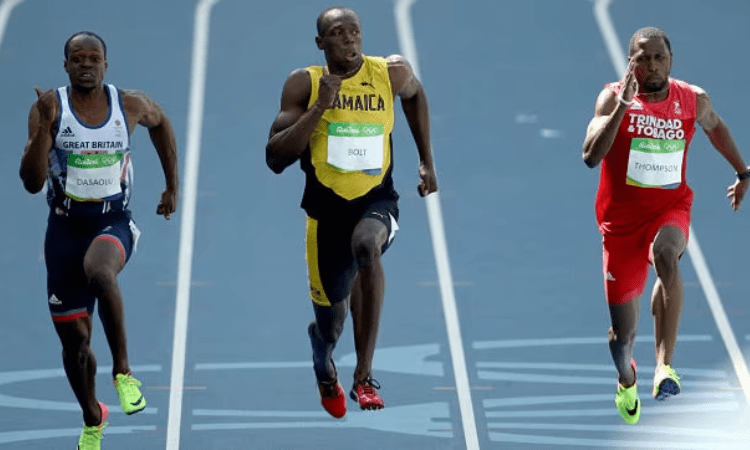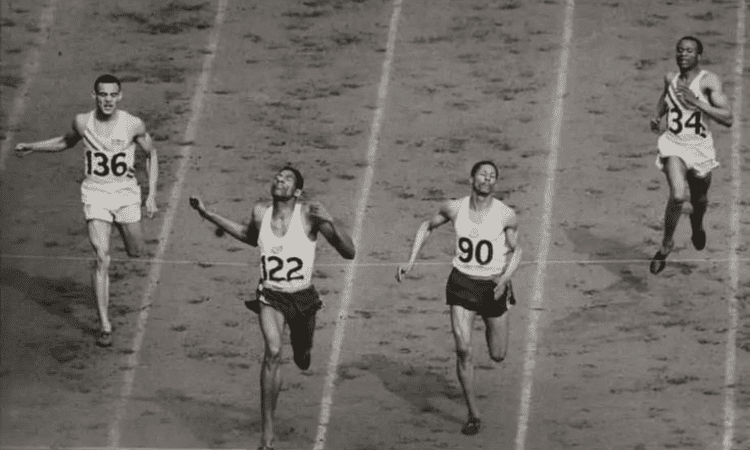Jamaica Track And Field 1910 To Present: The Track Field in Jamaica is huge. But, if you arrived from Mars, you would have missed an extraordinary period in World Athletics. The most entertaining, record-breaking, norm-shattering, jaw-dropping moments in the sport’s history, 2008-2016.
Jamaicans are track and field fanatics. So it’s only fitting that the most outstanding athlete sprang from its loin. The fastest human on earth and the quickest team on the planet came from Jamaica.
Usain Bolt, the fastest man on the planet and the most remarkable track and field athlete, leads his team, Jamaica, through the sport’s most successful period. Entertaining billions of adoring fans while looking fabulous and having fun.
Mr. Bolt, who retired in 2017, is now enjoying fatherhood, making music, building his brand, and enjoying the fruits of his labor. I am not here to talk about his exploits. They preserve it in films, prints, and music. Rather, I will look at the evolution of Jamaica’s Track and Field over a century. Also, the culture and system responsible for Jamaica’s dominance in the sprints.
The same environment in Jamaica produces and nurtures talented musicians. Exist for athletes, where their abilities develop naturally in their surroundings.
Early Beginnings: Boys and Girls Champs 1910 – The Foundation
Children on the Island develop their musical skills at an early age. Imitating famous musicians heard on the radio. They use their environment to produce Reggae infectious beats. Desktops in school, old buckets, tin cans, or anything they can manipulate to create melodies.
Many youths aspire to be like the popular entertainers of their time. Singing in the church choir, concerts, and competitions with peers sharpens their skills. It is hard to find a child in Jamaica who loves music and hasn’t played musical battles with friends or performed at church or school, or community events.
Track and Field in Jamaica is no different. As soon as a child learns to walk, running fast is the next progression. Jamaican children spend a lot of time outside playing. Foot race is typical; someone always tries to prove they are the fastest.
Jamaica Track And Field 1910 To Present
Schools are zoned based on their location. The best athletes from each zone compete for a spot on the parish team where the schools are located. Those who make the parish teams compete in the Parish Championship. All fourteen parishes participate, so athletes from all over the Island get to show off their skills.
Because of the rigorous qualification process, only the two best athletes from each parish compete in each event. Therefore, the competition standard is high. It also takes fewer days to complete.
The Jamaica Teachers Association (JTA) runs Parish Champs. It has a major sponsor and stage over two days.
These grass-root events play an essential role in track and field development in Jamaica.
Students get exposure to professional Coaches or trained physical education teachers. They also learn how to compete and negotiate the rounds. Some students compete for over four years at this level. By the time they get to high school, most master the basics of athletic training and competition.

Prep Champs, Parish Champs, and Primary Champs are where most of the Island’s top athletes get discovered and recruited to prominent high schools in track and field.
Some of Jamaica’s top Olympians and upcoming stars competed at these meets. Here are a few, Shelly-Ann Frazer Pryce, Usain Bolt, Yohan Blake, Warren Weir, Kerron Stewart, Raheim Chambers, Christopher Taylor, Veronica Campbell Brown, Merlene Ottey, and many more.
Jamaica has the biggest high school track and field meet in the world. The Inter-Secondary School Association (ISSA) Boys and Girls Championship is Earth’s only of its kind. In terms of competition, rivalry, performance, organization, atmosphere, history, and attendance.
Evolution of Jamaica’s Track and Field: From McKenley to Hemmings
Some excelled and continued at the senior level, while others improved significantly after Champs. Athletes such as Usain Bolt, Veronica Campbell, Yohan Blake, Merlene Ottey, Donald Quarrie, and Herb McKenley flourish at this level.
Shelly-ann Frazer Pryce, Elaine Thompson, and Asafa Powell competed, but they were not standouts. However, they improve significantly after high school.
At Champs, Asafa showed the sign of what was to plague his entire career. Underperformance on the big stage.
In his last year at Boys And Girls Champs in 2001, he was a favorite going into the class 1 boys 100m finals. But unfortunately, he couldn’t handle the pressure. False started and got disqualified. Despite being a favorite, the same scenario happened in 2003 at the World Championship disqualifications from the 100m finals. Again, choking under pressure, an albatross he could not cut loose.
Boys and Girls Champs Final Day
The girls’ competition is fierce among top schools. For almost two decades, Holmwood and Edwin Allen High shared the title. Previously, Vere Technical High School and St. Jago were the dominant teams.
The boys’ rivalry goes back for over a century. Kingston won over 30 times, the most by any school. Kingston College, Jamaica College, Calabar, Wolmers High, and Monroe College, are traditional schools that have been a part of since its inception.
People come to the national stadium to cheer for those teams, especially Jamaica College, Calabar, and Kingston College. However, most of their supporters never attended or connected to those schools.
Each top team fan takes over a section of the national stadium on Friday and Saturday. They religiously pack these sections every year. Spectators wearing purple and white (KC), green and black (Calabar), maroon and gold (Wolmers), blue and white (JC), and yellow and green (Saint Jago) dominate the stadium. The neutral fans and other teams sit in an area by themselves.
Champs’s atmosphere is festive, with outlandish hairstyles, horns, drums, waves, and dancing, worth miles going to see.
A winner of a hotly contested race runs to the section dominated by their supporters to salute, wave and bask in the adoration of fans.
The Island had been competitive for years, but it was the first time it dominated the USA in the sprints. This had the world asking, how do Jamaicans run so fast? What is their secret?
Success did not start for Jamaica in 2008, as some people might think. On the contrary, it started a long time ago. Jamaica won four medals at its first Olympics in 1948, one gold and two silver in Track and Field. In 1952, Jamaica won two gold and three silver medals in the following Olympics.
Jamaica Track And Field 1910 To Present
Every Jamaican knows about Arthur Wint, Jamaica’s first Olympic gold medalist. He won the 400m in the 1948 games in London. Also, the 1952 Olympic Games heroes in Helsinki, Finland, Arthur Wint, George Rhoden, Leslie Laing, and Herb McKenley. They dramatically defeated the USA in the men’s 4x400m relay, breaking the world record.
Although Herb McKenley never won an individual gold medal at the Olympics, he is the godfather of Jamaica’s track and field success. A versatile sprinter who ran the 100m, 200m, and 400m at a single Olympic game. An exceptional coach who molded many young minds and helped to build Jamaica’s track and field structure. He was president of the JAAA and coached the national team for many years.
As Jamaicans affectionally called him, Herb Mac ran the 100m as warm for the 400 and almost won. He broke the world record several times and was the first to run under 46 seconds for the 400m. His split of 44.6 seconds on the 4x400m at the 1952 Olympics was the fastest. After that, nobody ran a faster leg until the 1968 games.
Hon Herb McKenley’s inspirational athletic career, excellent coaching and motivation skills, national team leadership, and the JAAA set the foundation for Jamaica’s dominance in Track and Field.
The performances of the 1948 and 1952 Olympic teams were the blueprint for Jamaica’s track and field success. Jamaica failed to win a medal at only two Olympic games after 1952, the Melbourne Games in 1956 and Tokyo in 1964. They didn’t take part as a nation in the1960.
Jamaica Track And Field 1910 To Present
Jamaica came close to repeating its Gold medal-winning performance of the 1940s and 50s when Lennox Miller came second in the 100m finals at the Mexico games in 1968. Then, Donald Quarrie won Jamaica’s first Olympic gold medal at the 1976 Montreal Games since independence. He won the 200m and finished second in the 100m. This reignited Jamaica’s passion for Athletics and influenced the next star, Merlene Ottey.

Merlene Ottey never realized her dream of being an Olympic Champion. She came close several times. The closest and most controversial was finishing second in 100m at the 1996 Atlanta Olympics. Many people still believed they cheated her out of the gold medal.
She is an inspiration for Jamaica’s female athletes. Won many races, set many records, and motivated countless people. Since winning Jamaica’s first female Olympic medal at the 1980 Masco Olympics, she medaled at every game except Seoul, Korea, in 1988.
The last time she represented Jamaica was at the Sydney Games. At age 40, she won a bronze in the 100m and silver with the 4x100m team. Running on that relay team was a young Veronica Campbell Brown.
Deon Hemmings became Jamaica’s first female Olympic gold medalist at the 1996 Atlanta Olympic Games. Setting an Olympic record and raising the bar for the Island’s female Track and Field.
Her performance was special because she defeated American favorite world record holder Kim Batten in her backyard. However, she was not hot on Jamaica’s Track and Field radar, taking a different route to success.
Female athletes who came close to being Jamaica’s first Gold Medalist are Grace Jackson Small, second in the 200m at the 1988 Seoul Games, and Juliet Cuthbert Flynn, who came second in the 100m and 200m at the 1992 Barcelona games.
Ironically, a 400m hurdler and not a sprinter gave Jamaica its first female gold medal. Also, by someone not popular in Jamaica’s Track and Field culture. It almost mirrors Arthur Wint when he won the island gold medal in the 400m.
Jamaica Track And Field 1910 To Present
Some people regard 2004 to 2016 as Jamaica’s Track and Field’s Golden Era. The Athens Olympics was the start of Jamaica’s most successful period. Veronica Campbell Brown was the catalyst, winning Jamaica’s first Gold medal in the female Sprints. Victory in the 200m and 4x100m put her above Merlene Ottey.
The accomplishment of VCB and her teammates only open the appetite of a track-crazy nation. They were hungry for more success.
MVP Track Club based at the University of Technology and Racers Track Club at the University of the West Indies were two major players.
Track and Field clubs have been around since the 1970s. Alcan Track Club (Windalco), Racer Track Club, Kirkvine Track Club, Mobay Comets, Jamalco, and Bolts Of Lighting were a few that existed. The JDF and JCF also had a vibrant track program that allowed members to train and compete at national meets. There were also police youth clubs that took part in community events.
MVP Track Club: Changing Jamaica’s Athletic Landscape
Glen Mills has been coaching Caribbean athletes for decades. He trained two athletes who won medals at the World Championship in the 100m. Jamaican Raymon Stewart, 1987 silver medalist, Saint Vincent sprinter, Kim Collins 2003 winner.
Usain Bolt teaming with Glen Mills and his success at the 2008 Olympics brought in a wave of new talent to Racer Track Club. They launched the Racer Track Club in 2009 with the structure of a professional organization.
The success of the MVP and Racers Track Club showed local athletes that they didn’t have to go overseas to become world-class athletes. Instead, they could stay in Jamaica and be successful.
Other professional track clubs sprang after.
There are eight professional track clubs on the Island most of the senior athletes representing Jamaica belong to one of them.
- MVP Track Club
- Racers Track Club
- Sprint Teck Track Club
- Akan Track Club
- Swept Track Club
- Camron Blazers
- Legacy Track Club
- TITANS International Track Club
- The Gibson relay
- Western Relay
- Boys and Girls Champs
- JAAA Invitational
- Racers Grand Prix
The National Senior and Junior Trails.
Running is a natural part of all Jamaican children’s life. From informal to organized competition, all pass through these phases.
Jamaica’s track and field culture began in 1910 with the staging of the first Boys and Girls Champs. It laid the foundation for future success and made track an important part of the Island’s culture. Champs are a cultural phenomenon and have existed for over a century. It is the only of its kind in the entire world.
Jamaica’s greats excelled or took part in this competition and used it to launch their careers. The merger of Boys and Girls Champs in 1999 allowed the girls to showcase their talents in front of a larger audience. Thus, elevating their performance and inspiring more girls to enter the sport.
Professional Track Clubs in Jamaica: Fostering World-Class Athletes
Herb McKenley, George Rhoden Laing, and Arthur Wint set the foundation for Jamaica’s international track and field at the 1948 and 1952 Olympics. Their performance inspired all those who followed.
Lennox Miller and Donald Quarrie continued the tradition with success in the sprints. Then inspired Merlene Ottey, the first female Olympic medalist. Next, Juliet Cuthbert-Flynn took it further by winning double silver medals. Finally, Deon Hemmings started the golden age for females when she won the first gold medal for Jamaica and the English-speaking Caribbean at the 1996 Atlanta Olympic Games.
Veronica Campbell-Brown, inspired by Merlene Ottey, who attended Vere Technical High School, ushered in the golden generation. She won two gold at the Olympics in 2004.
Diversification of Success: Beyond Sprints
The creation of MVP, the first professional track club on the Island, changed Jamaica’s fortune in athletics forever. Asafa Powell, coached by Stephen Francis, founder of the MVP track club, broke the world record. This gave confidence to local coaches and athletes. They realized it was possible to dominate the world without leaving Jamaica.
This was an inspiration for Bolt and the Racers Track Club. Bolt dominated the sprints from 2008 to 2016, breaking all records and setting new boundaries. Many Jamaican athletes did well at international competitions. Shelly-Ann Frazer Pryce, Jamaica’s most successful female athlete, dominated the 100m at the World Championships and Olympics Games.
I hope you like the part where we talked about Jamaica Track And Field 1910 To Present. For more content like this, visit our website EBDTravel.com.
